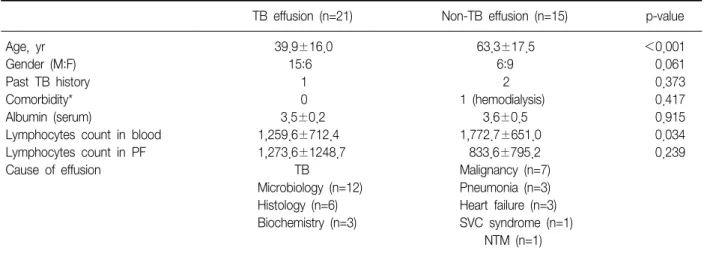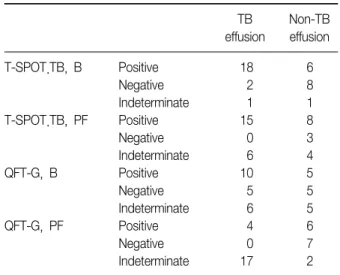Tuberc Respir Dis 2012;73:143-150
CopyrightⒸ2012. The Korean Academy of Tuberculosis and Respiratory Diseases. All rights reserved.
Clinical Utility of Two Interferon-gamma Release Assays on Pleural Fluid for the Diagnosis of Tuberculous Pleurisy
Ji Young Kang, M.D., Chin Kook Rhee, M.D., Na Hyun Kang, Ju Sang Kim, M.D., Hyoung-Kyu Yoon, M.D., Jeong Sup Song, M.D.
Department of Internal Medicine, The Catholic University of Korea College of Medicine, Seoul, Korea
Background: The release of interferon-gamma (IFN-γ) by T lymphocytes increases after rechallenge with Mycobacterium tuberculosis antigen, especially, at a localized site of tuberculosis (TB) infection. We aimed to compare the clincial efficacy of two commercial IFN-γ release assays from pleural fluid for the diagnosis in tuberculous pleurisy.
Methods: We performed T-SPOT.TB and QuantiFERON-TB Gold tests simultaneously on pleural fluid and peripheral blood samples from patients with pleural effusion, in South Korea, an area with intermediate TB burden.
Results: Thirty-six patients were enrolled prospectively, and tuberculous pleurisy was found in 21 patients. Both the numbers of IFN-γ secreting T cells and the concentration of IFN-γ were greater in the pleural tuberculous group, comparing with the non-tuberculous group. Moreover, in the tuberculous group, there was a significant difference in IFN-γ producing spot-forming cells using the T-SPOT.TB method between pleural fluid and peripheral blood. The receiver operating characteristic (ROC) curve, was the greatest for pleural fluid T-SPOT.TB test, followed by peripheral blood T-SPOT.TB test, peripheral blood QuantiFERON-TB Gold test, and pleural fluid QuantiFERON- TB Gold test (area under the ROC curve of 0.956, 0.890, 0.743, and 0.721, respectively). The T-SPOT.TB assay produced less indeterminate results than did QuantiFERON-TB Gold assay in both pleural fluid and peripheral blood.
Conclusion: These findings suggest that the pleural fluid T-SPOT.TB test could be the most useful test among the IFN-γ release assays for diagnosing tuberculous pleurisy in an area with an intermediate prevalence of TB infection.
Key Words: Interferon-gamma Release Tests; Tuberculosis, Pleural
Address for correspondence: Jeong Sup Song, M.D.
Department of Internal Medicine, Yeouido St. Mary's Hospital, The Catholic University of Korea College of Medicine, 62, Yeouido-dong, Yeongdeungpo-gu, Seoul 150-713, Korea
Phone: 82-2-3779-1102, Fax: 82-2-786-1518 E-mail: jssong@catholic.ac.kr
Received: Dec. 8, 2011 Revised: Jan. 30, 2012 Accepted: Aug. 2, 2012
CC


